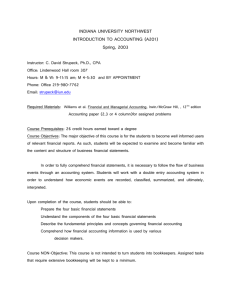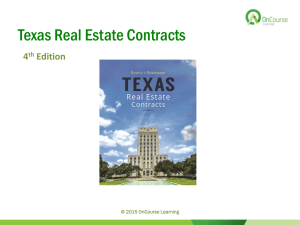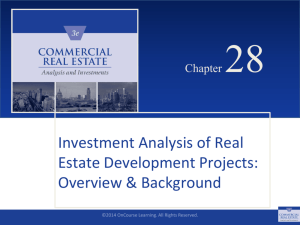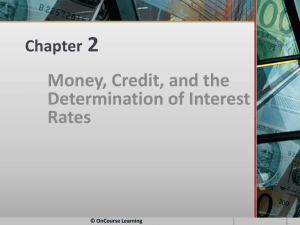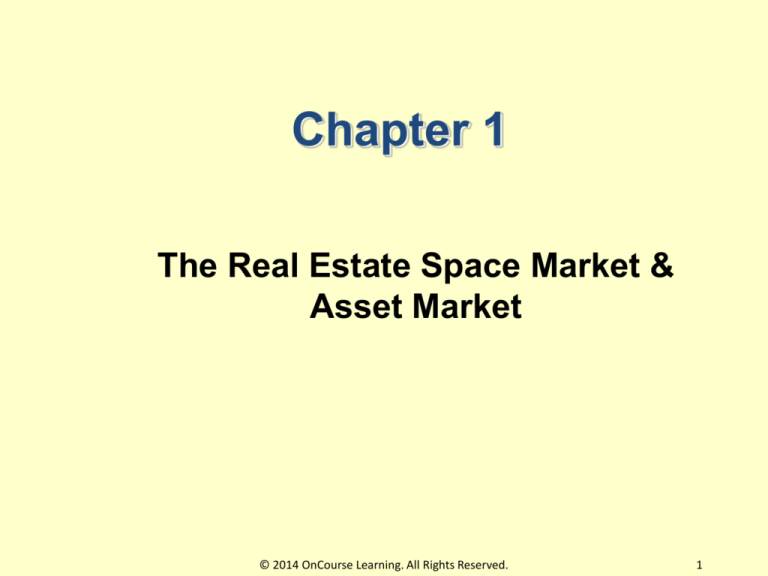
Chapter 1
The Real Estate Space Market &
Asset Market
© 2014 OnCourse Learning. All Rights Reserved.
1
What’s a “market”?…
A mechanism for the voluntary exchange
of goods and services among owners.
© 2014 OnCourse Learning. All Rights Reserved.
2
Two types of markets relevant
to commercial property:
1. The Space Market . . .
– For the usage (or right to use) “real property”.
– AKA “usage market”, or “rental market”.
– (e.g., tenants & landlords exchange money for
leases.)
2. The Asset Market . . .
– For the ownership of “real property”.
– AKA “property market”.
– (e.g., Oh.STRS exchanges my pension $ for an
office bldg.)
© 2014 OnCourse Learning. All Rights Reserved.
3
What’s “real property”?…
Ans:
Land & built space.
© 2014 OnCourse Learning. All Rights Reserved.
4
1.1.1 The Space Market…
Supply:
Demand:
Property Owners
(Landlords)
MARKET
Property Users
(Tenants)
Rents (e.g.$/SF)
Occupancy
© 2014 OnCourse Learning. All Rights Reserved.
5
1.1.2 “Segmentation” in the
Space Market…
A market is “segmented” if it breaks up
into sub-markets, or market segments.
Within each sub-market or segment, the
same good may have a different
equilibrium price.
The real estate space market is highly
segmented.
Why?…
© 2014 OnCourse Learning. All Rights Reserved.
6
Demand side:
Users require specific types of space… A
lawyer can’t use a warehouse. A trucking firm
can’t use a high-rise office bldg.
Users require specific locations (or types of
locations)… A lawyer won’t get much
business at the intersection of I-70 and I-77. A
trucking firm’s trucks would spend all their
time stuck in traffic if their warehouse were
located in downtown Cincinnati.
© 2014 OnCourse Learning. All Rights Reserved.
7
Supply side:
Buildings are of specific physical types
(warehouses high-rise offices).
Buildings are in specific locations (and
they can’t move!).
© 2014 OnCourse Learning. All Rights Reserved.
8
Concept check…
1. Is there a functioning market for
apartment rental in Cambridge?…
2. Is there a functioning market for
apartment rental in the Boston metro area
as a whole?…
3. Is there a functioning market for
apartment rental in the United States as a
whole?…
© 2014 OnCourse Learning. All Rights Reserved.
9
Concept check…
4. Is there a functioning market for “building
rental” in Cambridge?…
5. Is there a functioning market for gasoline
in the United States as a whole?…
6. Is there a functioning market for
apartment property ownership
(investment, as distinct from rental) in the
United States as a whole?… [Hint: this is
the asset market, not the space market.]
© 2014 OnCourse Learning. All Rights Reserved.
10
As a result of segmentation
in the space market…
As of the same point in time (in this
example, Oct.1992):
Class A Office Rents =
– $23/SF/yr Dntn Chicago.
– $33/SF/yr Dntn New York.
Rents in Suburban Dallas
– $ 7/SF/yr for Apartments.
– $13/SF/yr for Retail space.
© 2014 OnCourse Learning. All Rights Reserved.
11
1999 prices for a typical (same) house: 2200 SF, 4BR/2B, 2-car Garage…
City
Price
Index
Houston, TX
$115,000
50
Pittsburgh, PA
$163,000
70
Dallas, TX
$180,000
78
Atlanta, GA
$200,000
87
Cleveland, OH
$201,000
87
Cincinnati
$231,000
100
Chicago, IL (Schaumburg)
$300,000
130
New York, NY (Westchstr)
$353,000
153
Chicago, IL (Lincoln Pk)
$409,000
177
Boston, MA
$421,000
182
Los Angeles, CA (Hollywd)
$530,000
229
San Francisco, CA (city)
$720,000
311
$1,144,000
495
New York, NY (Manhattan)
Source: Caldwell-Banker
New York is 10-times Houston…
Boston is almost 3-times Pittsburgh:
“Location, location, location…”
© 2014 OnCourse Learning. All Rights Reserved.
12
Two major dimensions of
space mkt segmentation:
Geographic location
Property type
© 2014 OnCourse Learning. All Rights Reserved.
13
Geographic location:
Basic unit is the “metropolitan area”
(“MSA”)
Sub-markets (e.g., CBD, Suburban,
neighborhoods) also important
© 2014 OnCourse Learning. All Rights Reserved.
14
Property type:
Residential (apartment)
Office
Industrial (warehouse)
Retail
Other (hotels, health-care, etc…)
© 2014 OnCourse Learning. All Rights Reserved.
15
Example space market:
Cincinnati CBD Class A Office Mkt,
1980s-90s…
© 2014 OnCourse Learning. All Rights Reserved.
16
Exhibit 1-1: Office Demand as a Function of
Employment, the 1980s…
$25
GROWTH IN DEMAND
OVER TIME
REAL RENT
$20
$15
NEE
D=36
NEE
D=24
000 W
000 W
OR K
ERS
OR K
ERS
$10
$5
3.5
4
4.5
5
5.5
QUANTITY OF SPACE (Mil. SF)
6
6.5
Note: Pretty “normal” shaped demand function
© 2014 OnCourse Learning. All Rights Reserved.
17
1.1.3. The real estate space supply function
has a more peculiar shape…
Real estate space long-run supply is kinked…
$25
REAL ESTATE SUPPLY CURVE
REAL RENT
$20
KINK
LR
RISING
MC
$15
FALLI
N G LR
MC
EXISTING
QUANTITY
$10
$5
3.5
4
4.5
5
5.5
QUANTITY OF SPACE (Mil SF)
6
6.5
This is due to the longevity of buildings.
(You can add them a lot easier than you can subtract them!)
© 2014 OnCourse Learning. All Rights Reserved.
18
1.1.4 Supply, Development, & Rent…
Supply function
= Long-run Marginal Cost
function (LRMC)
LRMC
= Virtually zero (at and below
existing supply)
LRMC
= Development cost (beyond
existing supply)
Development cost = Construction + Land (including
developer profit)
© 2014 OnCourse Learning. All Rights Reserved.
19
• Rising LRMC (costs more to build next than last)
Land scarcity, Location demand growth
$25
REAL ESTATE SUPPLY CURVE
REAL RENT
$20
KINK
LR
RISING
MC
$15
FALLI
N G LR
MC
EXISTING
QUANTITY
$10
$5
3.5
4
4.5
5
5.5
QUANTITY OF SPACE (Mil SF)
6
6.5
• Falling LRMC (costs less to build next than last)
Loss of centrality, Location demand decline
© 2014 OnCourse Learning. All Rights Reserved.
20
• Rising LRMC (Islands, Growth constraints)
Manhattan, Boston, SF, Honolulu,…
$25
REAL ESTATE SUPPLY CURVE
REAL RENT
$20
KINK
LR
RISING
MC
$15
FALLI
N G LR
MC
EXISTING
QUANTITY
$10
$5
3.5
4
4.5
5
5.5
QUANTITY OF SPACE (Mil SF)
6
6.5
• Falling LRMC (Land available, Trans/Tel Infra)
Typical CBD in Midwest & South
© 2014 OnCourse Learning. All Rights Reserved.
21
In a market with expanding demand:
LR equilibrium rent
= “Replacement cost rent”.
= Rent the market tends to return to.
= Rent just sufficient to make new development
profitable.
© 2014 OnCourse Learning. All Rights Reserved.
22
Example: Cincinnati CBD office market, 1980s-90s…
Devlpt Cost = $200/SF (of blt space, inclu land +
construction)
Mid-1980s CBD office bldgs were selling at “8% cap
rates.”
That means investors at that time were willing to pay
$1 / 0.08 = $12.50
per dollar of current net income produced by the bldg.
© 2014 OnCourse Learning. All Rights Reserved.
23
Example: Cincinnati CBD office market, 1980s-90s…
Thus, if office bldgs could generate $16/SF of net
rent, then it would be just profitable to develop new
buildings:
$16 / 0.08 = $200 = Devlpt Cost
Thus, $16/SF is the LR equilibrium (“Replacement
Cost”) rent.
Rents at $16/SF or more, with cap rates at 8% or less,
would tend to trigger new development of downtown
office buildings in Cincinnati in the 1980s.
But would this new development really turn out to be
profitable?…
© 2014 OnCourse Learning. All Rights Reserved.
24
1.1.5. Forecasting Future Rents…
You need to forecast changes in both future
demand and future supply, and consider that
the “kink point” moves out with increases in
current stock of supply…
© 2014 OnCourse Learning. All Rights Reserved.
25
What happened in the Cincinnati office market
at the end of the 1980s, through early 1990s…
REAL RENT
$25
$20
D1
LRMC
16
$15
$10
S1
$5
3.5
4
4.5
5
5.5
QUANTITY OF SPACE (Mil
© 2014 OnCourse Learning. All Rights Reserved.
6
6.5
26
(1) Expecting demand to grow from D1 to D2,…
REAL RENT
$25
D2
$20
D1
LRMC
16
$15
13
$10
S1
$5
3.5
4
4.5
5
5.5
QUANTITY OF SPACE (Mil
© 2014 OnCourse Learning. All Rights Reserved.
6
6.5
27
(1) Expecting demand to grow from D1 to D2,
developers built 1 million SF new space (Chemed Ctr &
312 Walnut).
REAL RENT
$25
D2
$20
D1
LRMC
16
$15
13
$10
S2
S1
$5
3.5
4
4.5
5
5.5
QUANTITY OF SPACE (Mil
© 2014 OnCourse Learning. All Rights Reserved.
6
6.5
28
(1) Expecting demand to grow from D1 to D2,
developers built 1 million SF new space (Chemed Ctr &
312 Walnut).
REAL RENT
$25
D2
$20
D1
LRMC
16
$15
13
$10
S2
$5
3.5
4
4.5
5
5.5
QUANTITY OF SPACE (Mil
© 2014 OnCourse Learning. All Rights Reserved.
6
6.5
29
Chemed Center + 312 Walnut = 1 MSF Spec, 1990
© 2014 OnCourse Learning. All Rights Reserved.
30
(1) Expecting demand to grow from D1 to D2,
developers built 1 million SF new space (Chemed Ctr &
312 Walnut).
REAL RENT
$25
D2
$20
D1
LRMC
16
$15
13
$10
S2
$5
3.5
4
4.5
5
5.5
QUANTITY OF SPACE (Mil
© 2014 OnCourse Learning. All Rights Reserved.
6
6.5
31
But what happened in reality is . . .
(2) Demand stayed stuck at D1.
REAL RENT
$25
D2
$20
D1
LRMC
16
$15
13
$10
S2
$5
3.5
4
4.5
5
5.5
QUANTITY OF SPACE (Mil
© 2014 OnCourse Learning. All Rights Reserved.
6
6.5
32
But what happened in reality is . . .
(2) Demand stayed stuck at D1.
REAL RENT
$25
$20
D1
LRMC
16
$15
13
$10
S2
$5
3.5
4
4.5
5
5.5
QUANTITY OF SPACE (Mil
© 2014 OnCourse Learning. All Rights Reserved.
6
6.5
33
(2) Demand stayed stuck at D1 (or even fell temporarily
to D0, with recession of 1991).
REAL RENT
$25
$20
D1
16
LRMC
D0
$15
13
$10
S2
$5
3.5
4
4.5
5
5.5
QUANTITY OF SPACE (Mil
© 2014 OnCourse Learning. All Rights Reserved.
6
6.5
34
(3) Net rents fell from $16/SF to $13/SF or even as low
as $10/SF in the early 1990s.
REAL RENT
$25
$20
D1
16
LRMC
D0
$15
13
$10
S2
$5
3.5
4
4.5
5
5.5
QUANTITY OF SPACE (Mil
© 2014 OnCourse Learning. All Rights Reserved.
6
6.5
35
(3) Net rents fell from $16/SF to $13/SF or even as low
as $10/SF in the early 1990s. (They eventually
recovered by the late 1990s.)
How?…
REAL RENT
$25
$20
D1
16
LRMC
D0
$15
13
$10
S2
$5
3.5
4
4.5
5
5.5
QUANTITY OF SPACE (Mil
© 2014 OnCourse Learning. All Rights Reserved.
6
6.5
36
Exhibit 1-3: Change in Supply & Demand &
Rent over Time
REAL RENT
$25
D2
$20
D1
16
LRMC
D0
$15
13
$10
S1
$5
3.5
4
4.5
5
5.5
QUANTITY OF SPACE (Mil
© 2014 OnCourse Learning. All Rights Reserved.
S2
6
6.5
37
1.1.6. Is The Supply Function Rising, Level, or Falling?...
Exhibit 1-4: Long-run history of real home prices, building costs,
population, and interest rates in the United States.
250
1000
900
200
800
150
600
Home Prices
500
100
400
300
Building Costs
Population
50
200
Interest Rates
0
1880
Population in Millions
Index or Interest Rate
700
1900
1920
1940
1960
1980
2000
100
0
2020
Year
Source: Robert Shiller (website)
© 2014 OnCourse Learning. All Rights Reserved.
38
Real GDP, Population, Real Home Prices: 1952-2011…
Robert Shiller Real Home Price Index, NBER Recessions
1952=100
shaded bars = GDP recessions…
600
500
400
300
200
100
Real GDP
Population
2010
2008
2006
2004
2002
2000
1998
1996
1994
1992
1990
1988
1986
1984
1982
1980
1978
1976
1974
1972
1970
1968
1966
1964
1962
1960
1958
1956
1954
1952
0
Real Home Prices
© 2014 OnCourse Learning. All Rights Reserved.
39
Exhibit 1-5:
80
Manhattan Class A Office Market Rents: 1988-2010 Nominal & Real
Gross Asking Rent ($/SF-YR)
70
60
Nominal dollars
50
40
Real (constant
1988 dollars)
30
Real (constant
2010 dollars)
20
10
0
2010
2009
2008
2007
2006
2005
2004
2003
2002
2001
2000
1999
1998
1997
1996
1995
1994
1993
1992
1991
1990
1989
1988
Source: CBRE Econometrics
© 2014 OnCourse Learning. All Rights Reserved.
40
1.2 The Real Estate Asset Market (Property
Market)…
Supply:
Demand:
Investors
Wanting to Sell
MARKET
Investors
Wanting to Buy
Property Prices:
“Cap Rates”
1/($Asset/$Income)
© 2014 OnCourse Learning. All Rights Reserved.
41
For investors:
Real Estate Assets = Future Cash Flows
“Cash is fungible.”
Cash is cash is cash, whether it comes from real
estate, stocks, or bonds.
Real estate assets compete against stocks &
bonds. The real estate asset market is part of the
broader capital market .
© 2014 OnCourse Learning. All Rights Reserved.
42
Exhibit 1-6: Major Types of Capital Asset
Markets and Investment Products
Public
Markets:
Private
Markets:
Equity
Assets:
Stocks
REITs
Mutual funds
ETFs
Real Property
Private firms
Oil & Gas
Partnerships
Hedge Funds
Debt
Assets:
Bonds
MBS
Money
Bank loans
Whole
Mortgages
Venture Debt
instruments
© 2014 OnCourse Learning. All Rights Reserved.
43
Concept check…
1.
What is the difference between “equity” and
“debt” assets (investment products)?…
2.
What is the difference between “public” and
“private” asset markets?…
© 2014 OnCourse Learning. All Rights Reserved.
44
Magnitude
1.2.2 The Magnitude of Real Estate in the
overall Capital Market…
Exhibit 1-7 US Capital Market Sectors, a $70 Trillion Pie…
U.S. Capital Market Sectors, a $70 Trillion Pie
Private Debt
(49% RE), 16%
Public Debt
(22% RE), 30%
Private Equity
(78% RE), 30%
Public Equity
(17% RE*),
24%
*Corporate real estate owned by publicly traded firms, plus
REIT s.
Source: Authors' estimates based on Miles & T olleson
(1997)
updated with real
FRB statistics.
* Corporate
estate owned by publicly-traded
firms, plus REITs.
Source: Authors’ estimates based on Miles & Tolleson (1997).
© 2014 OnCourse Learning. All Rights Reserved.
45
Magnitude
Exhibit 1-8: US Investable Capital Market with Real Estate
Components Broken Out
U.S. Investable Capital Market with Real Estate Components
Broken Out. (Source: Based on Miles & Tolleson 1997)
Private Debt
9%
Stocks
26%
Bonds
24%
REIT Equity
0%
Private Commercial
MortgagesCMBS
1%
2%
RMBS
6%
Private Residential
Mortgages
6%
Agricultural/Timberl
ands
2%
Commercial Real
Estate Equity
House Equity
7%
17%
© 2014 OnCourse Learning. All Rights Reserved.
46
Real estate asset classes are:
Private Commercial Mortgages (2%)
CMBS (1%)
RMBS (6%)
Private Residential Mortgages (6%)
House Equity (17%)
Commercial Real Estate Equity (7%)
Agricultural/Timberlands (2%)
REITs (0.5%)
© 2014 OnCourse Learning. All Rights Reserved.
47
Another perspective on magnitude of real estate in the overall
capital market ($ trillion as of 2012)
US Investable Asset Sectors, a $82 Trillion Pie…
Houses, 20
Bonds, 38
CRE, 9
Stocks, 15
Note: CRE = Commercial Real Estate. There is some double-counting here, betw MBS
bonds & RE ($5T), & between REIT stocks & CRE ($0.5T).
© 2014 OnCourse Learning. All Rights Reserved.
48
How much real estate is there?...
Net Asset Value of U.S. Structures
($ billions, 2008, source BEA)
Total = $ 30,200
Govt. R.E.,
$5,751
Commercial
R.E., $8,922
Houses,
$15,527
About $30 trillion worth
© 2014 OnCourse Learning. All Rights Reserved.
49
How much commercial real estate is there?...
Net Asset Value of U.S. Commercial Real Estate Structures ($ billions,
2008, source BEA)
Total = $ 8,922 Billion
Institutional,
$1,420
Office, $1,779
Hotel &
Recreational,
$813
Retail, $2,040
Residential
(apts), $1,496
Industrial*,
$1,375
About $9 trillion worth
*Industrial excludes factories & manufacturing/extraction plants
© 2014 OnCourse Learning. All Rights Reserved.
50
How much commercial real estate is there?...
Market Size by Property type sin Rentable Building Area and
Market Cap Based on Mean Price for the Mid-Point of 2009
Property Type
Square Footage
$/SF Market Cap
Office
12,058,379,264
$102
$1,229,954,684,928
Industrial
23,851,606,671
$45
$1,073,322,300,195
2,907,635,121
$75
$218,072,634,075
17,336,105,191
$101
$1,750,946,624,291
Health Care
2,634,773,693
$490
$1,291,039,109,668
Hospitality
2,556,726,260
$95
$242,888,994,700
Mixed-Use
107,651,632
$95
$10,226,905,040
22,643,500,000
$62
$1,403,897,000,000
Flex
Retail
Multi-Family
Specialty, Sports & Entertainment
Total
NA
$1,953,008,671,667
84,096,377,832
$9,173,356,924,466
Source: Florance, Miller, Spivey, Peng, JREPM 16(2) 2010
© 2014 OnCourse Learning. All Rights Reserved.
51
Magnitude
Exhibit 1-9: Magnitude of U.S. Commercial Real Estate by
Sector, cerca 2010…
Exhibit 1-9a: U.S. Commercial Property by Physical Stock
(billions of square feet)
Total = 84 BSF (exclu Specialty/Entertnmt)
Mixed-Use
0.108
0%
Multi-Family
22.645
27%
Office 12.058
14%
Specialty/Enter
tainment 1953
21%
Office 1230
14%
Industrial 1073
12%
Industrial
23.852
28%
Hospitality
2.557
3%
Health Care
2.635
3%
Exhibit 1-9b: U.S. Commercial Property by Valuation
($ billions)
Total = $9,173 billion
Retail 17.336
21%
Flex
(Office/Indust)
2.907
4%
Multi-Family
1404
15%
Mixed-Use 10
0%
Health Care
1291
14%
Flex
(Office/Indust)
218
2%
Retail 1751
19%
Hospitality 243
3%
Source: CoStar.
© 2014 OnCourse Learning. All Rights Reserved.
52
Magnitude
Investable Real Estate Capital Structure
Total Equity:
$907.6 billion
REITs
19.0%
Private
Investors
51.6%
Total Debt:
$1,831.9 billion
+
Public Real
Estate LPs Pension
0.1%
Funds
20.9%
Foreign
Investors
5.3%
Commercial
Mortgage
Securities
21.4%
Mortgage
REITs
0.4%
Government
Credit
Agencies
Private
Financial
7.3%
Institutions
1.1%
Pension
Life Insurance Funds
2.3%
Companies
Savings
2.1%
Institutions
9.0%
=
Total Capital:
$2.7 trillion
Public Real
Estate LPs
0.0%
Private
Total Public Total
Debt
Equity
48%
6%
Total Private
Equity
Life Insurance
27%
Companies
15.9%
Commercial
Banks
43.7%
Total Public
Debt
19%
Source: Roulac Group (Investment Property Report, 12/11/02), & PPR Inc.
© 2014 OnCourse Learning. All Rights Reserved.
53
Magnitude
Evolution of U.S. Investable Real Estate Market
1982: $529 Billion
Public
Equity
1%
Public Debt
9%
Private
Debt
72%
Private
Equity
18%
1990: $1.4 Trillion
2002: $2.7 Trillion
Public
Equity
2%
Public Debt
10%
Private
Equity
29%
Private
Debt
59%
Public
Equity
6%
Public Debt
19%
Private
Equity
27%
Private
Debt
48%
Source: PPR
© 2014 OnCourse Learning. All Rights Reserved.
54
How is institutional real estate financed?...
Institutional Real Estate Capital Structure: 2011
$4.2 Trillion Instl Stock
Public Equity
18%
Private Equity
9%
Private Debt
47%
Public Debt
26%
Source: PPR, 2011
© 2014 OnCourse Learning. All Rights Reserved.
55
Exh.7-12: How is institutional real estate financed?... Buyers’ equity:
User/Other
Public/REIT
H1 '12
7%
2011
7%
2010
2008
40%
5%
32%
10%
2009
Private
Inst'l/Eq Fund
5%
31%
17%
41%
6%
8%
25%
6%
4%
11%
28%
18%
45%
8%
28%
50%
9%
2007 4%
12%
8%
15%
Non-Listed REIT
Cross-Border
7%
9%
10%
15%
24%
34%
6%
7%
8%
Properties $5M+
Source: Real Capital Analytics Inc.
© 2014 OnCourse Learning. All Rights Reserved.
56
Exh.7-13: How is institutional real estate financed?... Buyers’ debt:
Source: Real Capital Analytics Inc.
© 2014 OnCourse Learning. All Rights Reserved.
57
How is institutional real estate financed?...
Institutional Real Estate Debt Sources:
Outstanding Balance as of 2011
Mortgage
$3.1 Trillion Debt
REITS
5%
Commercial
Mortgage
Securities
20%
GSE/Gov't
Agencies
11%
Outstanding
Life Insurance
Companies
10%
Commercial
Banks
45%
Pension Funds
3%
Savings
Institutions
6%
Source: PPR, 2011
© 2014 OnCourse Learning. All Rights Reserved.
58
Real Estate vs Stocks & Bonds…
Investment “total return” includes income + capital growth:
Investment Total Return Performance (per annum avg) as of
June 30, 2012
15%
10%
5%
0%
Real Estate
(TBI*)
Stocks
1yr.
Bonds
5yr.
10yr.
T-Bills
20yr.
Total Investment Return Per Annum as of 2012(2Q)
0 Real Estate (TBI*)Stocks
Bonds
1yr.
12.51%
5.45%
8.32%
3yr.
12.06%
16.40%
5.65%
5yr.
0.59%
0.22%
6.64%
10yr.
8.84%
5.33%
5.36%
20yr.
9.24%
8.35%
6.24%
*Real estate represented by institutional grade investment property (NCREIF-based TBI transaction based index)
CPI
T-Bills
0.04%
0.10%
0.86%
1.76%
3.16%
CPI
1.66%
2.09%
1.95%
2.46%
2.49%
59
1.2.3. The Pricing of Real Estate Assets:
“Cap Rates”…
Commercial property prices are typically
quoted in terms of “Cap Rates” (short for
“capitalization rate”), AKA “OAR” (short
for “overall rate”).
CAP RATE
Current Annual Net Income
Pr operty Pr ice
© 2014 OnCourse Learning. All Rights Reserved.
60
The Cap Rate is like:
Current yield on the investment.
Inverse of “Price/Earnings” Multiple.
© 2014 OnCourse Learning. All Rights Reserved.
61
Property value can be represented (or
estimated) as:
Pr operty
Pr ice
Current Annual Net Income
CAP RATE
© 2014 OnCourse Learning. All Rights Reserved.
62
Three major determinants of cap rates …
1) The Opportunity Cost of Capital (OCC)
This comes from the capital market.
How much return can investor’s expect to earn
in other types of investments, like stocks,
bonds, money mkt?…
Higher real interest rates or higher expected
returns in other types of investments will
require higher expected returns in real estate,
and therefore higher cap rates, other things
being equal.
© 2014 OnCourse Learning. All Rights Reserved.
63
Three major determinants of cap rates …
2) Growth Expectations in the property’s future
cash flows
This comes from the space market.
How much can investor’s expect that this
property’s net cash flow (rents - expenses) will
be able to grow over the coming years?…
Higher (realistic) growth expectations will
allow a lower cap rate, as investors will be
willing to pay more $ today for a given amount
of current net income, in order to own the
property (since this income is expected to
grow).
© 2014 OnCourse Learning. All Rights Reserved.
64
Three major determinants of cap rates …
3) Risk perceptions and preferences among
investors, regarding the property.
This comes from both the space market and the
capital market (risk is relative).
How risky is an investment in this property, and
how much do investors care about that risk?…
Greater risk, and greater sensitivity to risk, will
require higher cap rates (lower asset values per
$ of current income).
© 2014 OnCourse Learning. All Rights Reserved.
65
Concept check…
Other things being equal, which would have the lower
cap rate, Property “A”, or Property “B”?…
1.
A: An apartment building in a declining
neighborhood.
B: An apartment building in a growing
neighborhood.
2.
A: An office building with full of long-term
tenants.
B: An office building full of short-term tenants.
© 2014 OnCourse Learning. All Rights Reserved.
66
Concept check…
Other things being equal, which would have the lower
cap rate, Property “A”, or Property “B”?…
3. A: Real estate when LT bonds yield 6% (with 3%
infla).
B: Real estate when LT bonds yield 8% (with 3%
infla).
4. A: A surface parking lot in a thriving downtown.
B: A 10-story parking garage in a thriving
downtown.
5. A: An office bldg with short-term below-mkt
leases in a growing rental market.
B: An office bldg with short-term above-mkt
leases in a declining rental market.
© 2014 OnCourse Learning. All Rights Reserved.
67
1.2.4 Asset Markets Are Not (very) Segmented…
“Physical Capital” = Real physical assets that
produce real goods or services over an extended
period of time.
“Financial Capital” = Money.
Physical capital is specific and relatively
immobile.
Financial capital is fungible (homogeneous) and
very mobile.
© 2014 OnCourse Learning. All Rights Reserved.
68
Physical Capital and Financial Capital
In the real estate asset market, financial
capital is used to purchase physical capital
assets.
The real estate space market deals with
physical capital.
The real estate asset market deals with
financial capital.
© 2014 OnCourse Learning. All Rights Reserved.
69
Financial Capital
Financial capital can quickly and easily flow
from a Manhattan office bldg to a Chicago
office bldg or a Dallas apt bldg. Returns are
returns are returns, because $$$ are $$$ are
$$$, whether those $$$ come from New
York office rents, Chicago office rents, or
Dallas apartment rents.
Therefore:
© 2014 OnCourse Learning. All Rights Reserved.
70
THE REAL ESTATE ASSET MARKET IS
NOT SEGMENTED LIKE THE SPACE
MARKET
Integrated (not segmented) real estate asset market
Asset prices are such that expected returns are
the same for properties with the same risk, across
different property market segments…
© 2014 OnCourse Learning. All Rights Reserved.
71
Exhibit 1-10: Typical Cap Rates, 3rd Qtr 1994:
Cap Rates (OARs) for Commercial Property
As of 3rd Quarter, 1994
0.12
11.20%
11.27%
10.57%
9.79%
0.1
9.60%
9.73%
9.44%
9.35%
Cap Rate (Income / Asset Value)
8.73%
0.08
8.90%
8.88%
7.73%
0.06
0.04
0.02
0
Malls
Office(CBD)
Office(LA)
Office(DC)
Warehouse
Hotels(Lux)
Property Type/Location
© 2014 OnCourse Learning. All Rights Reserved.
72
10%
Exhibit 1-11: Average Commercial Property Transaction Cap Rates:
2001-2010
9%
8%
Apts
Indust
Office
7%
Retail
6%
5%
2001
2002
2003
2004
2005
2006
2007
2008
2009
2010
Sourc e: Real Capital Analytics Inc
© 2014 OnCourse Learning. All Rights Reserved.
73
Concept check…
1)
Why are the cap rates lower for mall?…
2)
Why are the cap rates higher for hotels
and offices in “oversupplied” markets?…
© 2014 OnCourse Learning. All Rights Reserved.
74

